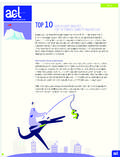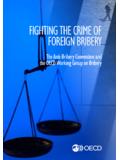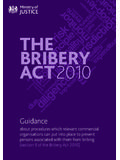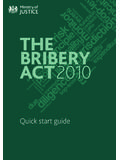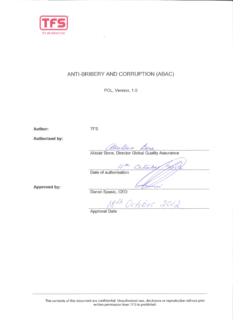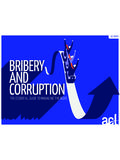Transcription of THE DETECTION OF FOREIGN BRIBERY - OECD.org
1 THE DETECTION OF. FOREIGN BRIBERY . The DETECTION of FOREIGN BRIBERY Please cite this publication as: OECD (2017), The DETECTION of FOREIGN BRIBERY , This work is published under the responsibility of the Secretary-General of the OECD. The opinions expressed and arguments employed herein do not necessarily reflect the official views of the OECD or of the governments of its member countries or those of the European Union. This document and any map included herein are without prejudice to the status or sovereignty over any territory, to the delimitation of international frontiers and boundaries and to the name of any territory, city, or area. OECD 2017. FOREWORD. Foreword The Convention on Combating BRIBERY of FOREIGN Public Officials in International Business Transactions (OECD Anti- BRIBERY Convention) states that BRIBERY raises serious moral and political concerns, undermines good governance and economic development, and distorts international competitive conditions.
2 Twenty years later, these words still hold true. While investigations and prosecutions are on the rise year after year, half of the countries of the 43 Parties to the OECD Anti- BRIBERY Convention have yet to conclude a FOREIGN BRIBERY enforcement action. To improve enforcement of the FOREIGN BRIBERY offence, the first step and challenge is the DETECTION of the offence. This study looks at primary DETECTION sources which have been, or could be expected to be, at the origin of FOREIGN BRIBERY investigations. These sources range from government agencies to private sector actors and individuals, at both domestic and international levels. These bodies are sometimes specifically identified in OECD anti- BRIBERY instruments as entrusted with a particular role in preventing and detecting FOREIGN BRIBERY . In other instances, the role played by these actors in the DETECTION of FOREIGN BRIBERY has emerged over the past twenty years of enforcement. This study was undertaken by the OECD Working Group on BRIBERY in International Business Transactions (WGB) in order to share experiences and good practices and to generally support efforts to better detect BRIBERY of FOREIGN public officials.
3 It builds on the information collected through the WGB's country reviews on enforcement of the Convention. The study has also benefited from input of experts in the specific areas under review. This study provides practitioners, legislators, policy makers, the private sector and civil society, with practical information on methods which have proven effective in practice in detecting FOREIGN BRIBERY and ensuring it is reported to relevant authorities. It provides examples, through specific case studies, of how FOREIGN BRIBERY has been identified in practice by particular sources and suggests ways in which these methods might be replicated or inspire improvements to further enhance DETECTION capacities. THE DETECTION OF FOREIGN BRIBERY OECD 2017 3. ACKNOWLEDGEMENTS. Acknowledgements This report was prepared by the Anti-Corruption Division of the OECD Directorate for Financial and Enterprise Affairs and developed within the OECD Working Group on BRIBERY in International Business Transactions.
4 The co-ordination and drafting of this report was led by France Chain with chapters also drafted by Leah Ambler, Catherine Marty, Lise Nee and Simone Rivabella. The authors acknowledge with gratitude the country mentors who contributed to the drafting of the different chapters, namely: Australia (Tom Sharp, Criminal Law Reform Section, Attorney-General's Department); Brazil (Vladimir Aras, Attorney General's Office and Georgia Diogo, International Cooperation Unit of the Brazilian Prosecution Service); France (Cyprien Scherrer, Head of the Strategic Analysis Unit, French Financial Intelligence Unit, TRACFIN); Germany (coordinated by Mr. Felix Burkhart , Federal Ministry for Economic Affairs and Energy, including input of the Federal Ministry of Finance and various agencies at L nder level); Israel (Yitzchak Yitzchak Blum, Deputy Director, Department of International Affairs Office of the State Attorney); Italy (Lorenzo Salazar, Substitute Prosecutor General, Naples); Netherlands (Albert Jan Kwakman and Peter Van Leusden, Dutch Fiscal Intelligence & Investigations Service).
5 Sweden (Alf Johansson, Chief Public Prosecutor); Switzerland (Stiliano Ordolli, Head of the Money Laundering Reporting Office-Switzerland, MROS); the United Kingdom (Laura Conway, Serious Fraud Office); and the United States (Andrew Gentin, Department of Justice, and staff from the Securities and Exchange Commission). The development of this report further benefited from the inputs of a number of consultation partners, namely: the Business and Industry Advisory Committee to the OECD (BIAC); the International Bar Association (IBA) (Jane Ellis); the Public Affairs and Media Division of the OECD Public Affairs and Communications Directorate (Spencer Wilson); the International Cooperation and Tax Administration Division of the OECD Centre for Tax Policy and Administration (Melissa Dejong); Transparency International UK; International Federation of Accountants (IFAC); the Secretariat of the Financial Action Task Force (FATF) (under the supervision of John Carlson); the Global Partnerships and Policies Division of the OECD Development Co-operation Directorate (Amanda Sporre); the Export Credits Division of the OECD Trade and Agriculture Directorate (Julian Paisey).
6 The Competition Division of the OECD Directorate for Financial and Enterprise Affairs (Antonio Capobianco); the Integrity Vice Presidency Unit of the World Bank Group (Mamta Kaushal); and the International Centre for Settlement of Investment Disputes (ICSID). The authors also wish to express their gratitude to the International Consortium of Investigative Journalists (ICIJ), the Organised Crime and Corruption Reporting Project (OCCRP), and the Global Investigative Journalism Network (GIJN) for disseminating the OECD Survey of Investigative Journalists to their membership. The Secretariat further conducted interviews with three journalists, which form the basis for some of the case studies in this chapter. 4 THE DETECTION OF FOREIGN BRIBERY OECD 2017. TABLE OF CONTENTS. Table of contents Introduction .. 9. Chapter 1. Self-reporting .. 13. 13. 1. Defining self-reporting .. 13. 2. Approaches to self-reporting for FOREIGN BRIBERY .. 14. 3. Incentivising self-reporting.
7 21. 4. Other factors which companies may consider in deciding whether to self-report .. 26. Conclusion .. 27. Chapter 2. Whistleblowers and whistleblower protection .. 29. 29. 1. How can whistleblowers be encouraged to report FOREIGN BRIBERY allegations to law enforcement authorities? .. 30. 2. How can whistleblowers be better protected against reprisals? .. 38. Conclusion .. 45. Chapter 3. Confidential informants and cooperating 47. 47. 1. Definitions and categories of confidential informants and cooperating witnesses .. 48. 2. Benefits to FOREIGN BRIBERY enforcement agencies of informants and cooperating witnesses .. 49. 3. Challenges in using cooperating witnesses and informants .. 52. 4. Developing incentives for cooperating witnesses and informants in FOREIGN BRIBERY cases .. 54. Conclusion .. 56. Chapter 4. Media and investigative journalism .. 57. 57. 1. Freedom of the press a pre-condition to reporting on 59. 2. Whistleblowers and protection of sources.
8 60. 3. Freedom of information and open data .. 62. 4. Interaction between journalists and law enforcement authorities in 64. 5. How to detect FOREIGN BRIBERY reported in the media .. 66. Conclusion .. 68. Chapter 5. Tax authorities .. 69. 69. 1 What role for the tax authorities? .. 70. 2. How to foster DETECTION .. 71. 3. How to detect FOREIGN BRIBERY in 78. Conclusion .. 82. THE DETECTION OF FOREIGN BRIBERY OECD 2017 5. TABLE OF CONTENTS. Chapter 6. Financial Intelligence Units .. 83. 83. 1. What role for the Financial Intelligence Unit? .. 85. 2. What can be detected? .. 86. 3. Who can detect and how? .. 89. 4. Fostering DETECTION .. 92. 5. The need for national multi-agency 95. 6. The key role of international cooperation .. 97. Conclusion .. 99. Chapter 7. Other government agencies .. 101. 101. 1. FOREIGN representations .. 102. 2. Export credit agencies .. 106. 3. Providers of Official Development Assistance .. 114. 4. Competition authorities.
9 120. Conclusion .. 126. Chapter 8. Criminal and other legal 127. 127. 1. DETECTION through criminal proceedings .. 127. 2. DETECTION through civil proceedings .. 131. 3. DETECTION through arbitral proceedings .. 132. Conclusion .. 135. Chapter 9. International co-operation .. 137. 137. 1. The need for efficient and proactive Central Authorities .. 137. 2. How can FOREIGN BRIBERY be detected?.. 138. 3. Referrals from International Organisations .. 141. 4. DETECTION through international cooperation in multijurisdictional cases .. 144. Conclusion .. 146. Chapter 10. Professional advisers .. 147. 147. 1. Accountants and auditors .. 148. 2. The legal profession .. 153. Conclusion .. 157. References .. 159. Boxes 1. United Kingdom Case Study: SFO v ICBC SB PLC (2015) .. 16. 2. Netherlands Case Study: SBM Offshore (2014) .. 17. 3. Norway Case Study: The Shipping Company Case (2014) .. 18. 4. United States Case Study: United States International Sales and Support, Inc.
10 (2012) .. 20. 6 THE DETECTION OF FOREIGN BRIBERY OECD 2017. TABLE OF CONTENTS. 5. Canada Case Study: Griffiths Energy International Inc. (2013) .. 24. 6. United States Case Study: Mikerin Case (2015) .. 29. 7. United States Case Study: International Game Technology (IGT) (2016) .. 43. 8. United States Case Study: Wadler v. Bio-Rad Laboratories, (2017).. 45. 9. United States Case Studies: Alstom (2014); Haiti Teleco (2011) .. 48. 10. Interview: Paolo Biondani, L'Espresso (Italy) .. 66. 11. Canada Case Study: Niko Resources (2011) .. 67. 12. Netherlands, Sweden and United States Case Study: Mission Investigate, . TeliaSonera and VimpelCom (2016) .. 67. 13. Organisational Models of Tax Agencies for Countering Tax Crimes in Parties to the OECD Anti- BRIBERY Convention .. 70. 14. How the automatic exchange of tax information between tax authorities may assist in future DETECTION of FOREIGN 76. 15. Germany Case Study: Intermediary case .. 80. 16. Organisational models of Financial Intelligence Units (FIUs).










